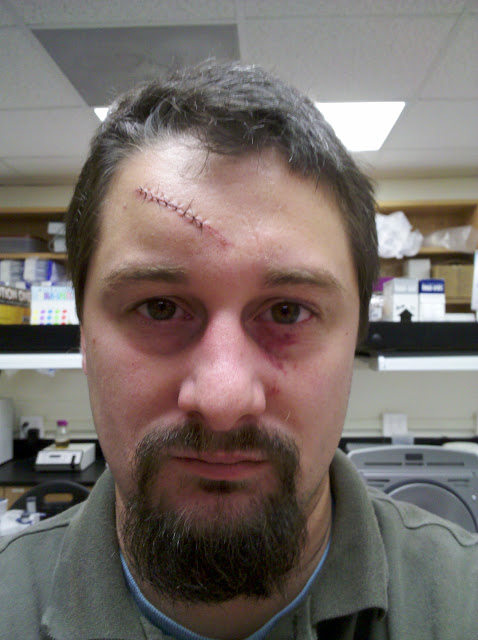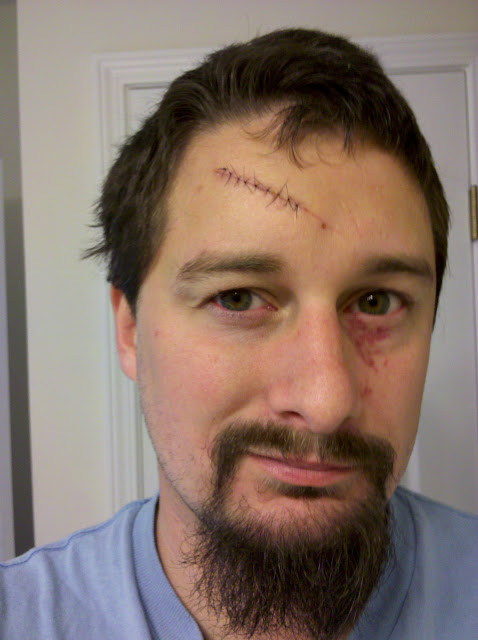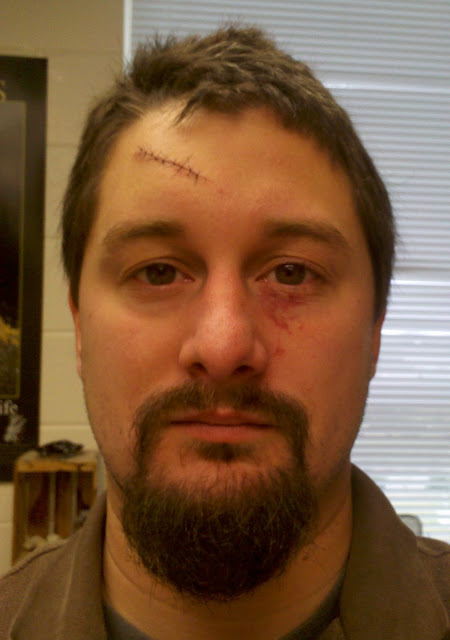 Those of you following me on twitter have probably heard that I had a little accident this weekend. And by “little accident”, I mean I got hit in the head with a machete. And by “got hit in the head” I really mean hit myself in the head while clearing brush. This has afforded me two opportunities: the first was the chance to see my own skull (how often does that happen?) and the second was the chance to document the healing process.
Those of you following me on twitter have probably heard that I had a little accident this weekend. And by “little accident”, I mean I got hit in the head with a machete. And by “got hit in the head” I really mean hit myself in the head while clearing brush. This has afforded me two opportunities: the first was the chance to see my own skull (how often does that happen?) and the second was the chance to document the healing process.
We don’t do a lot of medical blogging, primarily because we’re not in a medical field. There are excellent resources out there if you’re interested in medical blogging – Science-based Medicine and White Coat Underground are my favorite.
Below the fold are some rather tame pictures (but perhaps disturbing if you don’t like a little gore) of my head, post stitches. Sadly I was not in the right mindset to get a good picture of the injury before repair.

When dealing with an injury like this, the first thing you need to worry about after the bleeding stops is Tetanus. Tetanus disease is caused by a bacteria, Clostridium tetani, which occurs in soil, dust, and animal intestinal tracts throughout the world. The bacteria produces a clostridial neurotoxin that block neurotransmitter release and result in spastic paralysis and eventually death.
The tetanus toxin is the second deadliest poison known, with a lethal dose of 1 nanogram per kilogram. Unsurprisingly, the most lethal toxin known is also produced by a Clostridium bacteria, Clostridium botulinum. Thanks to the development and distribution of effective vaccines, tetanus poisoning is almost unheard of in the developed world, although an estimated 400,000 case still occur worldwide.
Fortunately, my tetanus shots were all up to date. I wonder if anti-vaccination proponents eschew tetanus shots after accidents?

So what’s going on beneath the surface?
Fortunately, I keep my machete clean and sharp, so the cut was clean and even, making it a perfect candidate for stitches. Head wounds bleed, a lot, and often look much worse than they really are. Well-aimed direct pressure kept bleeding to a minimum during the trip to the hospital and by the time is was ready to be seen, the bleeding had all but stopped. After suffering a traumatic laceration, blot begins to clot. The clot is a temporary barrier formed by blood platelets embedded in a fibrin matrix which protects the freshly exposed tissue and forms the foundation for wound healing. The clot provides a barrier, but for the type of wound caused by a machete to the head, the skin and underlying muscles must be cleaned and brought back together with stitches in order to properly heal.
Nine stitches to be precise.

Of course, this was also a head trauma, so not only is swelling an issue, but concussion is a concern. Concussion is a trauma to the brain, caused by whacking the brain against your skull. I didn’t show any early signs of concussion – no loss of consciousness, confusion, amnesia, headache, dizziness, ringing in the ears, nausea or vomiting, slurred speech, or fatigue, but over the next few days I had serious trouble concentrating on anything for more than a few minutes, so it’s likely than I had a mild concussion.
Over the next few weeks, as my head heals, I’ll go into some of the physiology of wound healing and perhaps a meditation or two on medical care. If any of our readers with a strong medical background are interested in writing a guestpost for Southern Fried Science, this could be your opportunity. Follow me on twitter or use the #machetemark hashtag for daily updates on the healing process.

And yes, that magnificent beard comes courtesy of Bluebeard’s Original beard wash, works great on blood stains, too. <- this is an unsolicited endorsement.
~Southern Fried Scientist
Bruggemann, H. (2003). The genome sequence of Clostridium tetani, the causative agent of tetanus disease Proceedings of the National Academy of Sciences, 100 (3), 1316-1321 DOI: 10.1073/pnas.0335853100
Montecucco, C., & Schiavo, G. (1994). Mechanism of action of tetanus and botulinum neurotoxins Molecular Microbiology, 13 (1), 1-8 DOI: 10.1111/j.1365-2958.1994.tb00396.x
Martin, P. (1997). Wound Healing–Aiming for Perfect Skin Regeneration Science, 276 (5309), 75-81 DOI: 10.1126/science.276.5309.75
If that is NOT the most convincing pirate costume, I don’t know what is. You always go all out for Halloween!
And as I know you know, and William will corroborate, you are sporting what (in PNG) is affectionately called “a scratch”. And in some parts of North Queensland, it’s a called “a Sheila Lure”.
I’m going to have to look into this “beard wash” thing.
You shoulda seen the other guy…
It’s just a flesh wound!
I was skeptical, but my beard is shockingly softer and significantly less itchy
I’ve had worse
“Fortunately, I keep my machete clean and sharp”
Is it weird that this is the second time this week I’ve heard that exact phrase?
Maybe perform some meditations on the proper way to swing an axe (or machete) too. 🙂
Did the machete bounce of the brush and strike you? Get better man.
From the angle of the cut, I gather you’re left-handed. Or was this a more complex accident than a simple bounce-back? In any case, I highly recommend renting a brush mower next time. They’re fast, relatively cheap to use, and tremendous fun.
Nice job on the wound-healing discussion, by the way. In the next post you can delve into the really cool process of scar formation.
I’m a righty. It was a bounce back off a thick branch at eye level that I tried to duck away from.